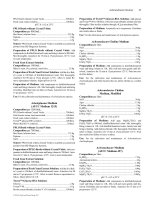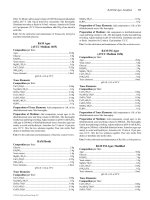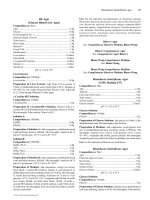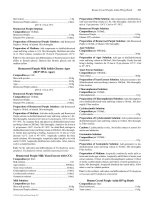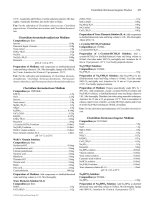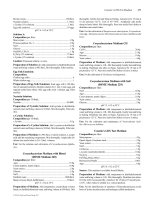Handbook of Small Electric Motors MAZ Part 5 ppsx
Bạn đang xem bản rút gọn của tài liệu. Xem và tải ngay bản đầy đủ của tài liệu tại đây (145.24 KB, 3 trang )
CONTENTS
Contributors xi
Preface
xiii
Acknowledgments
xv
Chapter 1. Basic Magnetics
1.1
1.1. Units / 1.1
1.2. Definition of Terms / 1.6
1.3. Estimating the Permeance of Probable Flux Paths / 1.21
1.4. Electromechanical Forces and Torques / 1.32
1.5. Magnetic Materials / 1.43
1.6. Losses / 1.52
1.7. Magnetic Moment (or Magnetic Dipole Moment) / 1.58
1.8. Magnetic Field for a Current Loop / 1.65
1.9. Helmholtz Coil / 1.67
1.10. Coil Design / 1.67
1.11. Reluctance Actuator Static and Dynamic (Motion) Analysis / 1.78
1.12. Moving-Coil Actuator Static and Dynamic (Motion) Analysis / 1.83
1.13. Electromagnetic Forces / 1.89
1.14. Energy Approach (Energy-Coenergy) / 1.91
Chapter 2. Materials 2.1
2.1. Magnetic Materials / 2.1
2.2. Lamination Steel Specifications / 2.4
2.3. Lamination Annealing / 2.6
2.4. Core Loss / 2.46
2.5. Pressed Soft Magnetic Material for Motor Applications / 2.51
2.6. Powder Metallurgy / 2.59
2.7. Magnetic Test Methods / 2.71
2.8. Characteristics of Permanent Magnets / 2.80
2.9. Insulation / 2.163
2.10. Magnet Wire / 2.176
2.11. Lead Wire and Terminations / 2.189
Chapter 3. Mechanics and Manufacturing Methods 3.1
3.1. Motor Manufacturing Process Flow / 3.1
3.2. End Frame Manufacturing / 3.4
3.3. Housing Materials and Manufacturing Processes / 3.10
3.4. Shaft Materials and Machining / 3.12
3.5. Shaft Hardening / 3.14
3.6. Rotor Assembly / 3.15
vii
3.7. Wound Stator Assembly Processing / 3.21
3.8. Armature Manufacturing and Assembly / 3.22
3.9. Assembly,Testing, Painting, and Packing / 3.23
3.10. Magnetic Cores / 3.25
3.11. Bearing Systems for Small Electric Motors / 3.46
3.12. Sleeve Bearings / 3.72
3.13. Process Control in Commutator Fusing / 3.79
3.14. Armature and Rotor Balancing / 3.87
3.15. Brush Holders for Small Motors / 3.99
3.16. Varnish Impregnation / 3.103
3.17. Adhesives / 3.109
3.18. Magnetizers, Magnetizing Fixtures, and Test Equipment / 3.124
3.19. Capacitive-Discharge Magnetizing / 3.138
Chapter 4. Direct-Current Motors 4.1
4.1. Theory of DC Motors / 4.1
4.2. Lamination, Field, and Housing Geometry / 4.46
4.3. Commutation / 4.84
4.4. PMDC Motor Performance / 4.96
4.5. Series DC and Universal AC Performance / 4.116
4.6. Shunt-Connected DC Motor Performance / 4.130
4.7. Compound-Wound DC Motor Calculations / 4.134
4.8. DC Motor Windings / 4.138
4.9. Automatic Armature Winding Pioneering Theory and Practice / 4.140
Chapter 5. Electronically Commutated Motors 5.1
5.1. Brushless Direct-Current (BLDC) Motors / 5.1
5.2. Step Motors / 5.47
5.3. Switched-Reluctance Motors / 5.99
Chapter 6. Alternating-Current Induction Motors 6.1
6.1. Introduction / 6.1
6.2. Theory of Single-Phase Induction Motor Operation / 6.5
6.3. Three-Phase Induction Motor Dynamic Equations and Steady-State Equivalent
Circuit / 6.38
6.4. Single-Phase and Polyphase Induction Motor Performance Calculations / 6.45
Chapter 7. Synchronous Machines 7.1
7.1. Induction Synchronous Motors / 7.1
7.2. Hysteresis Synchronous Motors / 7.5
7.3. Permanent-Magnet Synchronous Motors / 7.9
7.4. Performance Calculation and Analysis / 7.16
Chapter 8. Application of Motors 8.1
8.1. Motor Application Requirements / 8.1
8.2. Velocity Profiles / 8.4
viii
CONTENTS
8.3. Current Density / 8.9
8.4. Thermal Analysis for a PMDC Motor / 8.10
8.5. Summary of Motor Characteristics and Typical Applications / 8.32
8.6. Electromagnetic Interference (EMI) / 8.32
8.7. Electromagnetic Fields and Radiation / 8.35
8.8. Controlling EMI / 8.38
Chapter 9. Testing 9.1
9.1. Speed-Torque Curves / 9.1
9.2. AC Motor Thermal Tests / 9.5
9.3. DC Motor Testing / 9.9
9.4. Motor Spectral Analysis / 9.15
9.5. Resonance Control in Small Motors / 9.27
9.6. Fatigue and Lubrication Tests / 9.36
9.7. Qualification Tests for Adhesives and Plastic Assemblies / 9.42
9.8. Trends in Test Automation / 9.43
Chapter 10. Drives and Controls 10.1
10.1. Measurement Systems Terminology / 10.1
10.2. Environmental Standards / 10.4
10.3. Feedback Elements / 10.9
10.4. Comparisons Between the Various Technologies / 10.42
10.5. Future Trends in Sensor Technology / 10.48
10.6. Selection of Short-Circuit Protection and Control for Design E Motors / 10.51
10.7. Switched-Reluctance Motor Controls / 10.65
10.8. Basic Stepping-Motor Control Circuits / 10.70
10.9. Current Limiting for Stepping Motors / 10.80
10.10. Microstepping / 10.93
10.11. Brushless DC Motor Drive Schemes / 10.97
10.12. Motor Drive Electronic Commutation Patterns / 10.119
10.13. Performance Characteristics of BLDC Motors / 10.122
References R.1
Bibliography B.1
Index I.1
About the Contributors C.1
About the Editors E.1
CONTENTS
ix

